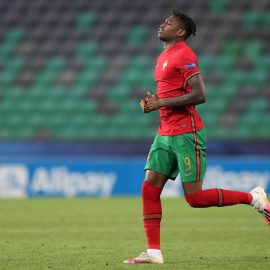How does one go about measuring greatness in football? I mean real, obvious, blatant greatness; that rarest of qualities. Today “greatness” is such a woolly, over-used term that sometimes we lose its meaning and start labeling all sorts of mundane, workaday things as “great”. The evolution of language has distilled its meaning, reduced its potency, but we still know greatness when we see it.
However, the very idea of finding some sort of gauge on which to measure greatness, particularly in sport, can be extremely problematic. The main issue with bestowing greatness upon an individual athlete is that it is near impossible to avoid straying from objectivity and into the territory of personal, subjective judgments.
To one man Pele might be the greatest of all-time, to another it will be Maradona and to another perhaps Di Stefano. When it comes to the greatness of individuals, the subjective cannot be avoided because the statistics don’t always add up. George Best never inspired Northern Ireland to World Cup success, Gianfranco Zola never fired Chelsea to a Premier League title, but that does not mean they were not great players.
Individual brilliance does not always shine through in statistical records, there is also an intangible quality that is almost impossible to describe. We just seem to know it when we are witnessing it.
When it comes to the records of clubs, however, it is possible to be a little more objective when forming opinions. Sheer weight of silverware is as good a gauge as any, a tangible measure by which to assess the relative “greatness” of some of the game’s most successful clubs.
In this article I will be using a simple formula to come to some sort of conclusion as to which are the most successful clubs in the history of the sport. Obviously it’s not flawless, I’m no mathematician, but it’s something.
By awarding 1 point for major domestic trophy triumphs (e.g. FA Cup, Coppa Italia), 2 points for a minor continental trophy (UEFA Cup, Cup Winner’s Cup, World Club Cup etc), 3 points for a league title and 5 points for a major continental trophy (Champions League, Copa Libertadores etc), I hope to reach a rudimentary verdict as to which clubs around the world can truly come to be considered “great”.
I have decided to exclude secondary domestic cup competitions (e.g. the Carling Cup) and titles which are decided by a one-off fixture (e.g. the European Super Cup) from the list, because they are not held in quite the same regard as the other competitions and, in the case of the Super Cup, can only be contested by clubs that have already won silverware the previous season.
For the European teams, to avoid clubs from smaller, less competitive leagues dominating the list through sheer weight of trophies won in relatively weak competitions, I will multiply each club’s league title points score by the UEFA coefficient of its domestic league to provide a more balanced figure. Hopefully all will become clear…
Most Successful Clubs by Region
AFC
(Asia & Australia)
Seongnam Ilhwa Chunma (7 league titles, 1 domestic cup, 0 minor continental trophies, 1 major continental trophy) = 27
With the advent of professional football being a relatively recent occurrence in the Far East, the statistics for some of the region’s most successful clubs may not look particularly impressive, but this is an area where football is growing more rapidly than anywhere else on the planet and should not at all detract from the achievements of the AFC’s most dominant teams.
During the 20 years since the club’s foundation, South Korea’s Seongnam Ilhwa Chunma have grown quickly to become a dominant force in the Asian game. 7 K-League championships make the club the most successful in the relatively brief history of Korean professional football, whilst an AFC Champions League triumph in 1995-96 confirmed Seongnam’s position at the very pinnacle of Asian football.
CAF
(Africa)
Al-Ahly (34 league titles, 35 domestic cups, 4 minor continental trophies, 6 major continental trophies) = 175
Egypt’s Al-Ahly have dominated African club football for the best part of sixty years, serial successes making the club the most decorated outside of Europe. Not content only with domestic supremacy, Al-Ahly are also the most successful team in the history of the CAF Champions League with a highly impressive six titles, four having come in the last nine years.
Today “The Red Devils” continue to possess a highly talented squad, the likes of Ahmad Belal and Mohamed Aboutrika contributing to a smooth and aesthetic style of football which will, in all probability, lead to Al-Ahly continuing their ascendancy over the African game in the coming years.
CONCACAF
(North America, Central America & The Caribbean)
C.D. Saprissa (28 league titles, 0 domestic cups (n/a), 5 minor continental trophies, 3 major continental trophies) = 109
Although it is perhaps the Mexican sides who grab most of the headlines when it comes to Central American football, it is Costa Rica’s C.D. Saprissa who are the most decorated club in the region. With 28 domestic titles and 3 CONCACAF Champions League trophies to their name, Saprissa have secured their status as one of the very best sides in Latin America, but it was the club’s performance in the 2005 World Club Cup that gained them the most attention.
Going into the competition as, on paper at least, the weakest side in the tournament, Saprissa beat Sydney F.C. 1-0 in the quarter-final before putting in a decent performance against Liverpool, eventually going down 3-0 to the European Champions. The club’s performance in the tournament equaled the best ever by a team from the CONCACAF region and further raised the growing international profile of the prolific Saprissa.
CONMEBOL
(South America)
C.A. Penarol (46 league titles, 0 domestic cups (n/a), 0 minor continental trophies, 5 major continental trophies) = 163
Uruguay, one of world football’s earliest powerhouses, may have seen its influence on the global game diminish with the passing of the decades, but Penarol, the South American nation’s most prestigious club, have continued to be a significant force on the continent despite their country’s gradual decline on the international stage.
With 46 league titles, the last being won in 2003, Penarol are certainly well established as the strongest side in Uruguay and, despite perhaps lacking the worldwide profile of the likes of Boca Juniors and River Plate, their five Copa Libertadores triumphs show that the club deserve to be more widely recognised as one of South America’s most prestigious footballing establishments.
OFC
(Oceania)
Auckland City F.C. (4 league titles, 0 domestic cups (n/a), 0 minor continental trophies, 2 major continental trophies) = 22
Although, with the move of Australia into the Asian zone, the OFC region is almost certainly the weakest of FIFA’s global administrative areas in plain footballing terms, Oceania does possess a number of successful clubs that will be hoping to develop a more global presence as the game continues to develop in the region.
New Zealand is the strongest football nation in the region and it’s most prominent club, Auckland City F.C., can lay claim to being the best in the OFC. The club has won four domestic titles in the last four seasons and is the current holder of the Oceania Champions League title, having won it in 2008/09 and also three seasons earlier in 2005/06. If Auckland – and OFC football in general – can find the greater investment needed to develop the game further, then there’s no reason why club’s like Auckland can’t establish themselves as a more significant international force in the years to come.
UEFA
(Europe)
Real Madrid C.F. (31 league titles x 74.266 UEFA coefficient, 17 domestic cups, 2 minor continental trophies, 9 major continental trophies) = 159 (without coefficient) 2330.246 (with coefficient)
Although Rangers are the most decorated football club in Europe, when adjusted by the UEFA coefficients it is, almost poetically, Real Madrid who come out on top. The world’s richest, most glamorous club have dominated Spanish football since the 1930s and were voted the most successful club of the 20th century in FIFA’s official poll.
A club with a gloriously rich history, some of the game’s greatest ever players have plied their trade for Madrid during its 107 year existence. It is names like Di Stefano, Puskas, Gento, Butraguengo and Zidane that have established Madrid as the best club in Europe over the last century and give the club its air of grandeur and majesty. With a new generation of galacticos now in residence at the Estadio Santiago Bernabeu it’s almost certain that Real Madrid will continue to be a major force in world football for the foreseeable future.
European Top 10 (Using UEFA coefficients)
Real Madrid (2330.246)
Juventus (1713.570)
Rangers (1483.500)
Barcelona (1443.054)
Liverpool (1355.982)
Manchester United (1355.982)
Bayern Munich (1210.595)
Celtic (1205.750)
Ajax (1157.770)
Benfica (1157.322)
Add Sportslens to your Google News Feed!






